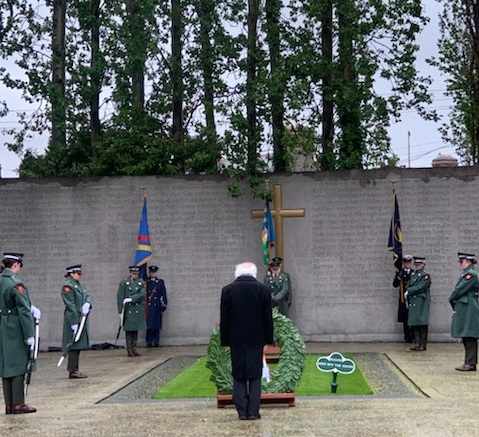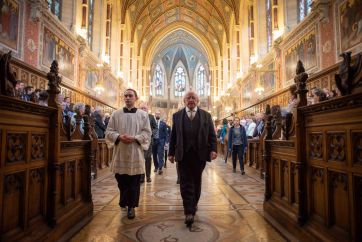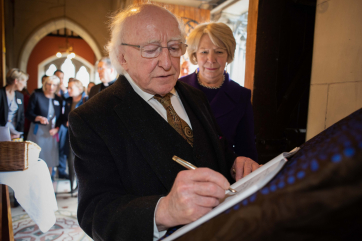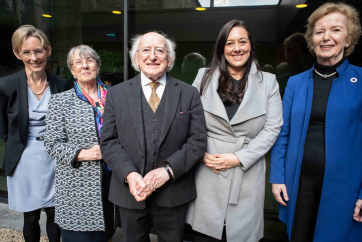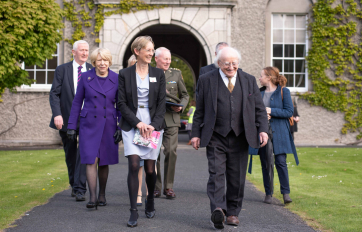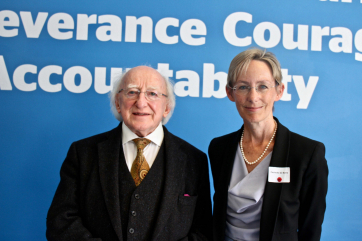Speech at the Official Opening of a Polish Exhibition on the Great Famine
Royal Irish Academy, Dublin, Wednesday, 8 May 2019
A chairde,
It is a real honour to be present with you all today here in the Royal Irish Academy to launch officially the exhibition entitled, A Forgotten Polish Hero of the Great Irish Famine: Paul Strzelecki’s Struggle to Save Thousands. May I congratulate the organisers of this exhibition, the Embassy of Poland in Dublin, together with our hosts in the Royal Irish Academy. May I also thank Prof. Peter Gray of Queen’s University Belfast and Prof. Emily Mark-FitzGerald of University College Dublin for their illuminating respective research inputs, as well as Ger Garland for her graphic design and aesthetic contribution to the exhibition.
Ireland and Poland have much in common. Our shared history is enriched by deep economic, cultural and personal ties, as well as our shared membership of the European Union. Contemporary Irish-Polish relations are dynamic and growing, bolstered in no small part by the vibrant Polish community in Ireland, men and women who have chosen to make Ireland their home and who, may I acknowledge, are making such a vital contribution to our society.
Together with our experience of being caught in the injustices of empires, their conflicts and our struggle for independence, it is perhaps our mutual, shared and sometimes painful histories of migration that provide such a striking commonality. For those of us who have been students of migration, the seminal work on Polish migration to America by Thomas and Znaniecki, ‘The Polish Peasant in Europe and America’, remains one of the classical founding studies on migrants at points of origin and destination.
Today, we are recognising a special friend of the Irish, Paul (Paweł) Edmund Strzelecki, one of the great Polish humanitarians of the nineteenth century. This exhibition tells the captivating story of Strzelecki, an explorer and geologist by profession, thanks to whose efforts perhaps some 200,000 children were saved from starvation during the Great Irish Famine of the 19th century. Strzelecki was the main agent of the British Relief Association, a charity established by a group of prominent philanthropists in 1847, that was the largest private provider of relief during the Great Irish Famine and Scottish Highland Potato Famine of the 1840s.
Strzelecki developed a visionary and effective mode of assistance: feeding starving children directly through the schools. He extended daily food rations to schoolchildren across the most famine-stricken western part of Ireland, while also distributing clothing and promoting basic hygiene. At its peak in 1848, around 200,000 children from all denominations were being fed, many of whom would have otherwise perished from hunger and disease.
On an occasion like today, at which we discover the detail of his heroic work and formally mark Polish links to the Great Famine in Ireland, it is important to recall all those who suffered and perished during this most defining event in the making of contemporary Ireland. That catastrophe in terms of human impact was, as we now recognise is true of all famines, ultimately political and economic in its origins. We are morally challenged to reject any suggestion that its human toll was unavoidable, inevitable, or indeed, as some sources put it, an act of God.
By 1849 the nation was in the midst of the apocalyptic conditions of the fourth year of famine, at a time when the responsibility for public action had, in effect, been abdicated by the British Government and passed to the indebted Irish Poor Law Unions. In this year, one of the first professors recruited to the newly established University College Cork, was the distinguished mathematician George Boole, who described what he witnessed on his rail journey from Dublin to Cork: “There is over the whole country an air of utter destitution and abandonment”. This was a theme that was recorded earlier in a number of accounts by European travellers, including the 1837 account of the Hungarian Baron József Eötvös. A decade before the arrival of potato blight, the precarious position of a large swathe of the population was already a matter of public record. The script for the devastation that was to follow ten years later had largely been written.
It is impossible, in my view, to adequately deal with the Great Famine without reference to the plantations, dispossessions and exclusions that created a particular congested dispersal of population on impossible holdings of land and serf-like conditions. George Cornewall-Lewis’s Third Report of the Irish Poor Law Inquiry Commissioners is a particularly interesting account because it provides an insight into what insiders at the time admitted (it is rarely admitted now) as to the British Government’s real intentions in relation to Ireland: to clear the land of tenants and secret organisations through harsh Workhouse regimes.
As a surviving people in appalling conditions with an enforced migratory diaspora, Ireland and Irish people would become totally changed by the Famine. We are only now, assisted with recent advances in new scholarship, such as UCC’s Atlas of the Irish Famine, and encouraged by new cultural endeavours, such as that which is represented here today, taking into ourselves the depth of the complexity of the Great Famine and, thus, feel able to confront the consequences of the tragic events which took place on our island 170 years ago. Our own past, the dynamics of our own history, and its relationship with our neighbours, the changes in social forces in our own country, and how it would inform our politics, cannot be understood without an understanding of the Great Famine.
We know from the 1841 Census that some 40 percent of Irish families were recorded as living in nearly half a million of what was called a bothán, a one-room mud-hut described on the Census as “fourth-class houses” that were considered generally unfit for human habitation. The families who lived in a bothán were drawn overwhelmingly from either the over 3 million landless agricultural labourers in Ireland at the time, or the nearly 1.5 million cottiers that were leasing tiny plots of land, often barely enough to keep their families alive.
They, like the tenant categories above them, had no security of tenure, but were frequently without the means of survival itself, and, with nothing to sell, were without the means to flee. The English journalist Joseph Kay was appalled to learn that their homes were simply destroyed when they were evicted:
“If they do not pay their rent at the proper time, they are liable to be turned adrift, even in the middle of the night, into the bleak road, without a shelter, and with their helpless wives and children. No notice is necessary; no notice is given.”
These classes of men, women and children in the lower reaches of the class pyramid – the labourers and the cottiers – bore the very worst consequences of the Famine. It is they who are, in statistical terms, more likely to be found amongst the more than one million who died. If some were lucky enough to be assisted, such as those 200,000 children helped by Paweł Strzelecki, they are among the 2 million who subsequently emigrated to places like Britain, North America and Australia.
There are of course countless others who, without the resources to emigrate, gathered in the large towns and cities, for between 1844 and the 1850s, many, including pregnant women, took to the roads to survive. The 1851 census records only 135,000 habitations described as bothán, testament not to any programme of assistance, but to the obliteration and destruction of any record that these families had even lived their lives on the land.
The Great Famine, an Gorta Mór, though not the sole foundation event in the formation of the Irish diaspora – after all, over a million Irish people had emigrated to North America between 1815-1845 – must yet still be considered the single most important event in the formation of a distinct Irish-American cultural identity. Some 2.1 million people left this island in the decade between 1846 and 1855, more than in the previous two-and-half centuries combined, and 1.5 million of them settled in the United States, even if it was Canada that had been their point of disembarking.
Their migration made a legacy that had been foretold with apprehension. In 1860 the Times of London has been quoted as saying the following:
“If this goes on as it is likely to go on … the United States will become very Irish … So, an Ireland there will still be, but on a colossal scale, and in a new world. We shall only have pushed the Celt westwards. Then, no longer cooped between the Liffey and the Shannon, he will spread from New York to San Francisco, and keep up the ancient feud at an unforeseen advantage (…) We must gird our loins to encounter the nemesis of seven centuries’ misgovernment. To the end of time a hundred million spread over the largest habitable area in the world, and, confronting us everywhere by sea and land, will remember that their forefathers paid tithe to the Protestant clergy, rent to the absentee landlords, and a forced obedience to the laws which these had made.”
Indeed, this article was prescient, as, by 1901, more people born in Ireland were living outside the island of Ireland than living within it. They, the Irish abroad, would play a crucial role in the cultural revival and the preparations for independence, both parliamentary and military.
I am struck by the parallel Polish experience of emigration, in particular to the United States. In the period from the early 1800s to the beginning of World War II, records indicate that approximately 5 million Polish emigrated to the United States. These Poles fled their country for various reasons: some left to escape conscription, others left to seek better opportunities in the United States, and some fled from religious persecution.
The Ireland of the late 1840s had not experienced the impact of the public health reforms championed by Edwin Chadwick. Sanitation and water supplies were compromised, leading to a huge incidence of diseases such as typhus, yellow fever and cholera. In his testimony to a House of Lords Committee in 1847, Father Theobald Mathew, whose statue adorns Cork’s St. Patrick’s Street, described his efforts to bury the dead:
“Each day there was a large pit dug, and all that died that day were put down; the pit was covered up; I had four men employed. Some days there were sixty or seventy a day buried, and some days more.”
Accounts such as this, which lay bare the “averted gaze” as I have written elsewhere, demonstrate an absence of, as Father Mathew suggested, solidarity and empathy for human suffering, should be grounds for our reflection. We have also to place such an account alongside the extraordinary accounts of the visit of Queen Victoria to Cobh and Cork, in the midst of jubilant crowds of prosperous citizens, whilst unseen to the visiting monarch, those whom contemporaries termed “shadows and spectres”, “ghastly skeletons” and “phantoms” wandered the streets of the city.
Father Mathew issued a statement that is so much a credit to his obvious anger, criticising the Cork Council for having beggars routinely rounded up every night:
“Under the Authority of an Act of Parliament they take up sturdy beggars and vagrants, they confine them at night in a Market Place, and the next morning send them out in a cart five miles from the town, and there they are left, and a great part of them perish, for they have no homes to go to.”
There are lessons that can be drawn from the obvious crisis and destitution of the people and the indifference to it. Only a pernicious and dangerous economic orthodoxy could morally sanction poverty amidst plenty, conspicuous consumption amidst mass slaughter – an ideology that elevated the right of property above any version of natural law, even while it relegated the duty of humanity and of solidarity to the arena of charity. Were it not for those like Paweł Strzelecki, the numbers who died of starvation would, of course, have been even higher. In February 1847, Strzelecki reached Westport and wrote, “No pen can describe the distress by which I am surrounded.” His testimony broke the silence as it was published by several British newspapers and helped to illuminate the plight of suffering in Ireland.
Despite this, the British Government which had sanctioned the withdrawal of Government support in the midst of Black ’47, also, as scholars Amartya Sen and Mike Davis have reminded us, attempted to rationalise the monumental catastrophes suffered in the same manner as those done to the Indian people and the inaction of the British Raj during the Indian Famines of 1876-1878, 1896-97, and 1899-1900. Despite the British Government cutting State-backed Famine relief in 1847, Strzelecki remained in Ireland, assisting poor families until 1849, even though he himself was suffering from the effects of typhoid fever contracted in Ireland.
Strzelecki also helped impoverished Irish families to seek new lives in Australia where he had been an explorer in the years prior to arriving in Ireland. During his three years in Ireland, he never sought any remuneration for his work. His commitment was widely recognised and praised by his contemporaries, and it is appropriate that, in May 2015, a plaque honouring Strzelecki’s efforts was unveiled by Lord Mayor Christy Burke and the Mayor of Poznán, Mr Jacek Jaśkowiak, and can be found on Sackville Place in the heart of Dublin’s city centre. This exhibition this evening, and I so wish it well, rightly endeavours to bring his achievements and legacy more widely into the public eye.
How should we now reckon with the Famine? Let us do so with new histories, new intellectual work to inform policy that does not eschew moral purpose, that does not accept bogus inevitabilities, that tests assumptions, and is dedicated to telling the story of the people; let us do so through a renewed commitment to solidarity, in a spirit of hope and a generous welcome to all models of possibility, with all those who still now suffer as our ancestors, at home and overseas, once did.
May I conclude by once again thanking the Polish Embassy in Ireland for coordinating this exhibition which I understand is a flagship initiative dating back to 2016 when the then Ambassador Sarkowicz advocated the idea to commemorate the work of Paweł Strzelecki in Ireland, a hugely significant contribution to the alleviation of suffering and death during this, our darkest time in recent Irish history. On behalf of the people of Ireland, I wish to thank Poland for Paweł Strzelecki’s service to our nation, and I wish the exhibition every success.
Go raibh mile maith agaibh go léir.

